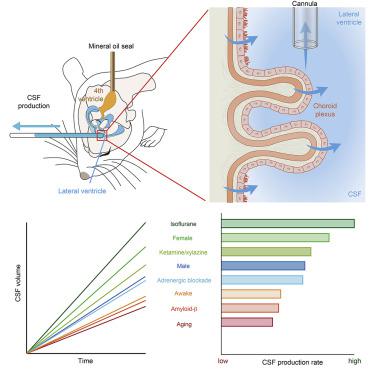Cell Reports ( IF 7.5 ) Pub Date : 2020-12-22 , DOI: 10.1016/j.celrep.2020.108524 Guojun Liu 1 , Humberto Mestre 2 , Amanda M Sweeney 3 , Qian Sun 3 , Pia Weikop 4 , Ting Du 5 , Maiken Nedergaard 6

|
The emerging interest in brain fluid transport has prompted a need for techniques that provide an understanding of what factors regulate cerebrospinal fluid (CSF) production. Here, we describe a methodology for direct quantification of CSF production in awake mice. We measure CSF production by placing a catheter in a lateral ventricle, while physically blocking outflow from the 4th ventricle. Using this methodology, we show that CSF production increases during isoflurane anesthesia, and to a lesser extent with ketamine/xylazine anesthesia, relative to the awake state. Aged mice have reduced CSF production, which is even lower in aged mice overexpressing amyloid-β. Unexpectedly, CSF production in young female mice is 30% higher than in age-matched males. Altogether, the present observations imply that a reduction in CSF production might contribute to the age-related risk of proteinopathies but that the rate of CSF production and glymphatic fluid transport are not directly linked.
中文翻译:

小鼠脑脊液生成的直接测量
对脑液运输的新兴兴趣促使需要能够了解调节脑脊液 (CSF) 产生的因素的技术。在这里,我们描述了一种直接量化清醒小鼠脑脊液产生的方法。我们通过在侧脑室中放置一根导管来测量 CSF 的产生,同时物理阻断从 4 th 的流出心室。使用这种方法,我们表明,相对于清醒状态,异氟醚麻醉期间脑脊液的产生增加,而氯胺酮/甲苯噻嗪麻醉的程度较小。老年小鼠的脑脊液产生减少,而在过表达淀粉样蛋白-β 的老年小鼠中,脑脊液的产生甚至更低。出乎意料的是,年轻雌性小鼠的脑脊液产生量比同龄雄性小鼠高 30%。总而言之,目前的观察结果表明,脑脊液产生的减少可能会导致与年龄相关的蛋白质病风险,但脑脊液产生的速度与淋巴液转运没有直接关系。


















































 京公网安备 11010802027423号
京公网安备 11010802027423号